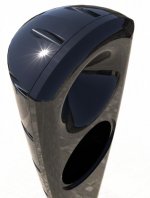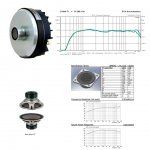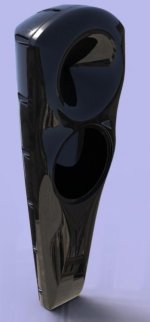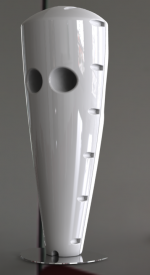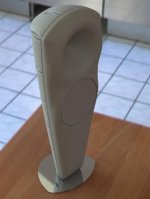This is all academic though - the ribbon failed after two hours of listening.
Pretty much agrees with what I have heard about them as well.
The thing is, beyond what I said before, ribbons are the wrong shape for good directivity control - they are very hard to do a good waveguide for. And, as I said, the bottom line is that they end up working like a compression driver. I've know lots of people who try them, but nobody who has stayed with them. Theoretically I just don't see an advantage.
For the "usual" planar's I tend to agree.
With one of the new AMT's on a horn combined with advanced EQ'ing its a different story – plenty of clean SPL and great "non fatigue" resolution up to the top end.
Michael
I would dearly like to try a TPL150 but they are very expensive. Not sure what profile the factory horn is. However, it wouldn't be too hard to do an OS horizontally and maybe vertically in wood by hand.For the "usual" planar's I tend to agree.
With one of the new AMT's on a horn combined with advanced EQ'ing its a different story – plenty of clean SPL and great "non fatigue" resolution up to the top end.
Michael
Probably won't happen for years as I'm happy with my DE25, 250 and ND1090s, the first Ti phrammed driver I have ever liked.
I would dearly like to try a TPL150 but they are very expensive. .
Heil Oskar and the whole *s..ty* patent system being a downright (negative) example on how things get blocked for centuries !!!
Succession like Mundorf and Beyma just follow in the high price footsteps to my distress.
These device' could easily be sold - with margin - at a fraction of the current price, they are such simple.
Michael
In EU the new Mundorf 2310E cost 270EUR, and 2510E is 350EUR, and Beyma 500EUR, with horn almost 600EUR
But I dont think I would cross any of them lower than 2khz
But I dont think I would cross any of them lower than 2khz
In EU the new Mundorf 2310E cost 270EUR, and 2510E is 350EUR, and Beyma 500EUR, with horn almost 600EUR
But I dont think I would cross any of them lower than 2khz
Exactly, Eton and ESS being in the same range and for the cheap(?) Aurum Cantus AMT I haven't found a supplier, ADAM not selling to the DIY AFAIK....
Last edited:
Hit or kitsch?
Don't know without any measurements 😉 But why the sharp edge on top? If your enclosure production process allows for very large radii (to smooth edge diffraction) then this is the number one feature you should be after.
Best, Markus
Looks very nice, but I also have to ask - why not a nice large radius?
Hit or kitsch?
More radius, no edges on the top corners, and fewer pocket-holes for screws and that's a winner.
Edge looks fine to me, not sharp at all
Anyway, its whats closest to driver that matters most, screws, chassis, and such
Imagine the edge you often have from countersinking a driver, its worse, much worse
Anyway, its whats closest to driver that matters most, screws, chassis, and such
Imagine the edge you often have from countersinking a driver, its worse, much worse
Last edited:
Not yet because we discuss final shape and we haven't decided final HF driver. Also upgrading my measurement setup one level up. Choice is between STX D-800Ti, Monacor MRD-160 and BMS4358 or 2,5" BMR. STX is fine but has screw mount that we don't like.
For Earl information that STX could install your Fresnel phase plug.
For Earl information that STX could install your Fresnel phase plug.
Attachments
Hello jzagaja,
Beautifull made! Looking forward to see the final shape. Do you have plans to sell the enclosure separately to the DIY-community?
Greetz,
Wim
Beautifull made! Looking forward to see the final shape. Do you have plans to sell the enclosure separately to the DIY-community?
Greetz,
Wim
If you can do it, respect
1. Woofer should not point downwards
2. Why not do a bit nicer back, and sides
2a. Or instead make the front baffle much deeper, nice sides always look good
3. Your changes looks nice, but doubtfully good fore sound, too many abrupt surface changes
4. I would sculpture the foot base as an integrated part of mold, and with enough room fore crossover
1. Woofer should not point downwards
2. Why not do a bit nicer back, and sides
2a. Or instead make the front baffle much deeper, nice sides always look good
3. Your changes looks nice, but doubtfully good fore sound, too many abrupt surface changes
4. I would sculpture the foot base as an integrated part of mold, and with enough room fore crossover
Last edited:
Hello jzagaja,
I agree with tintus that pointing the woofers downwards might not be the best option. His idea to sculpture the foot base as an integrated part of mold is also very good. I think because most of the weight will be in the upper part of the speaker, the foot base will be a real challange to make the speaker vibration free and stable (you do not want it to tilt over when one of the childeren runs into it) without spoiling the looks with a very large foot.
As your target is the DIY market (most of us prefer sound quality above looks...), I would propose and enclosure more like was posted by John Sheerin in post 2912 (but with your round waveguide).
Greetz,
Wim
I agree with tintus that pointing the woofers downwards might not be the best option. His idea to sculpture the foot base as an integrated part of mold is also very good. I think because most of the weight will be in the upper part of the speaker, the foot base will be a real challange to make the speaker vibration free and stable (you do not want it to tilt over when one of the childeren runs into it) without spoiling the looks with a very large foot.
As your target is the DIY market (most of us prefer sound quality above looks...), I would propose and enclosure more like was posted by John Sheerin in post 2912 (but with your round waveguide).
Greetz,
Wim
- Home
- Loudspeakers
- Multi-Way
- Geddes on Waveguides
